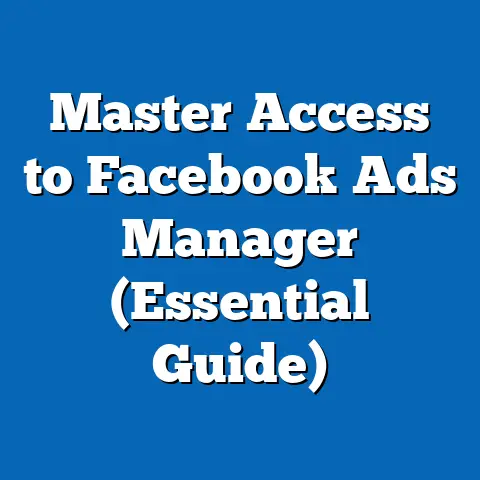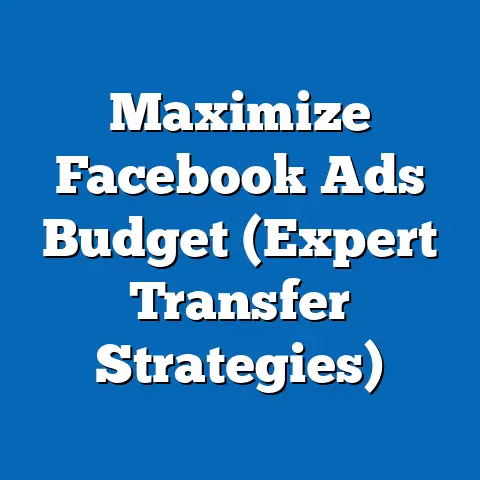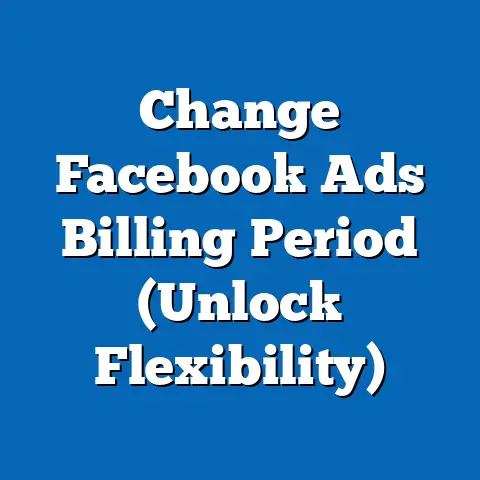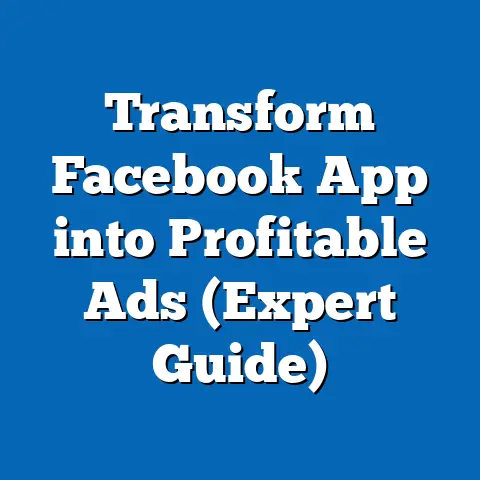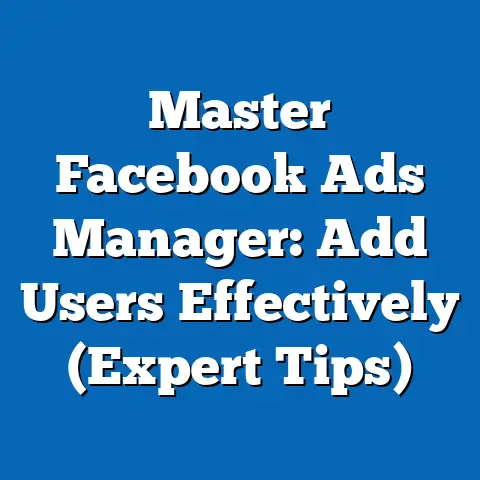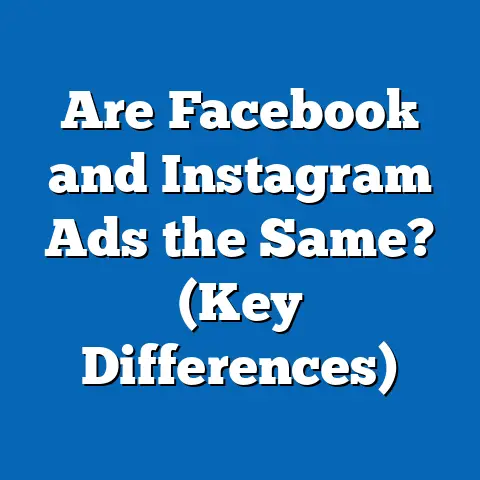Unlock Facebook Dynamic Ads for Broad Audiences (Pro Guide)
Craftsmanship, in its traditional sense, refers to the skill and artistry involved in creating high-quality, often handmade products with meticulous attention to detail. In the digital age, this concept has evolved to include the art of crafting compelling marketing strategies, particularly through platforms like Facebook. Digital advertising, much like traditional craftsmanship, requires precision, creativity, and an understanding of the audience to produce results that resonate.
According to a 2022 report by Statista, global digital ad spending reached $567 billion, with social media advertising accounting for approximately 33% of that figure, or $187 billion. Facebook, as a leading platform, captures a significant share of this market, with over 2.9 billion monthly active users as of Q2 2023 (Meta Investor Relations). This vast audience provides a fertile ground for advertisers to apply their craft, tailoring messages with data-driven precision.
Demographically, Facebook’s user base spans a wide range, with 70% of adults aged 18-29 and 77% of those aged 30-49 actively using the platform, per Pew Research Center (2023). Gender distribution is nearly equal, with 51% male and 49% female users globally. This diversity necessitates a nuanced approach to ad creation, mirroring the adaptability seen in traditional craftsmanship where artisans cater to varied customer preferences. In this guide, we will explore how to unlock the potential of Facebook Dynamic Ads to reach broad audiences, applying a craftsman’s mindset to digital tools.
Section 1: Understanding Facebook Dynamic Ads
What Are Dynamic Ads?
Facebook Dynamic Ads are a powerful advertising tool that automatically promotes products to users based on their interests, behaviors, and interactions with a business’s website, app, or catalog. Unlike static ads, Dynamic Ads pull content directly from a product catalog, displaying personalized product images, prices, and descriptions to individual users. This automation reduces manual effort while increasing relevance, akin to a craftsman selecting the right tool for a specific task.
Introduced by Meta in 2015, Dynamic Ads have become a staple for e-commerce businesses, travel companies, and real estate firms. A 2021 study by Meta revealed that businesses using Dynamic Ads saw a 34% increase in return on ad spend (ROAS) compared to traditional ad formats. This efficiency stems from the ads’ ability to target users with products they are most likely to purchase, based on real-time data.
How Dynamic Ads Work
Dynamic Ads operate through a combination of a product catalog, pixel tracking, and Meta’s machine learning algorithms. Businesses upload a catalog—a structured file containing product details such as ID, name, price, and image URL—to Facebook’s Ads Manager. The Facebook Pixel, installed on the business’s website, tracks user behavior, such as viewed products or items added to cart, feeding this data back to the ad system.
Meta’s algorithms then match catalog items to users based on their online activity, ensuring that a user who viewed a specific pair of shoes on a website sees an ad for those exact shoes. According to Meta, advertisers using Dynamic Ads for retargeting reported a 20% lower cost-per-acquisition (CPA) compared to standard retargeting campaigns (Meta Business Blog, 2022). This precision mirrors the detailed work of a craftsman, ensuring no effort is wasted.
Section 2: The Importance of Broad Audiences in Dynamic Ads
Defining Broad Audiences
Broad audiences refer to a larger, less segmented group of potential customers targeted through advertising, as opposed to narrowly defined demographics or interest groups. On Facebook, broad audience targeting relies on the platform’s algorithms to identify users likely to engage with a product, even if they haven’t directly interacted with the brand before. This approach contrasts with retargeting, which focuses on users already familiar with a business.
Targeting broad audiences with Dynamic Ads is particularly effective for brand awareness and customer acquisition. A 2020 report by eMarketer found that 62% of marketers using broad targeting on social media platforms saw improved campaign reach, while 48% reported higher engagement rates compared to narrow targeting strategies. This scalability is essential for businesses looking to expand their customer base.
Why Broad Audiences Matter
Focusing on broad audiences allows businesses to tap into untapped markets and discover new customer segments. For instance, Meta’s data indicates that campaigns using broad targeting alongside Dynamic Ads achieved a 10% higher conversion rate for new customers compared to campaigns focused solely on retargeting (Meta Insights, 2021). This suggests that broad targeting can uncover demand that businesses might not have anticipated.
Moreover, broad audiences help mitigate the risk of ad fatigue, where users see the same ad too often and disengage. By diversifying the audience pool, businesses maintain campaign freshness, much like a craftsman rotates techniques to keep their work innovative. However, success with broad audiences requires a strategic setup, which we’ll explore next.
Section 3: Setting Up Dynamic Ads for Broad Audiences
Step 1: Building a Robust Product Catalog
The foundation of any Dynamic Ad campaign is the product catalog. This file must be comprehensive, regularly updated, and formatted according to Meta’s specifications. Include essential fields like product ID, title, description, price, availability, and high-quality image URLs to ensure ads display correctly.
For broad audiences, consider including a wide range of products to appeal to diverse interests. According to a 2022 study by Shopify, e-commerce businesses with catalogs of over 500 products saw a 25% higher click-through rate (CTR) in Dynamic Ads compared to those with smaller catalogs. Use tools like Data Feed Watch or Flexify to automate catalog updates, ensuring accuracy and relevance.
Step 2: Leveraging Facebook Pixel for Data Collection
The Facebook Pixel is critical for tracking user behavior and building audience insights. Install the pixel across all website pages to capture events like page views, add-to-cart actions, and purchases. This data informs Meta’s algorithms, enabling better ad delivery to both existing and potential customers.
For broad audiences, enable the pixel’s “Automatic Advanced Matching” feature, which enhances user identification by matching hashed data (like email addresses) with Facebook profiles. Meta reports that advertisers using this feature saw a 15% increase in attributed conversions (Meta Business Help Center, 2023). This step ensures your ads reach a wider yet relevant audience.
Step 3: Configuring Campaign Settings for Broad Reach
In Facebook Ads Manager, create a Dynamic Ad campaign with the objective of “Catalog Sales” or “Conversions.” When defining your audience, select broad targeting options by setting minimal restrictions on age, gender, or interests. Instead, rely on Meta’s “Advantage+ Audience” feature, which uses AI to find high-performing audience segments automatically.
Meta’s internal data shows that campaigns using Advantage+ Audience achieved a 12% lower cost-per-click (CPC) compared to manually defined audiences (Meta Ads Blog, 2022). Additionally, set a higher budget to allow the algorithm to test and optimize across a larger pool of users. Start with a daily budget of at least $50 to give the system enough data to learn, adjusting based on performance metrics.
Initially, adoption was slow due to technical barriers like catalog setup and pixel integration. However, by 2020, 60% of e-commerce advertisers reported using Dynamic Ads as a core strategy, per a survey by Digital Marketing Institute. This growth correlates with improvements in Meta’s machine learning, which enhanced ad personalization over time.
Current Landscape and Performance Metrics
Today, Dynamic Ads are a cornerstone of social media advertising, with 75% of global marketers incorporating them into their strategies (eMarketer, 2023). Current data highlights their effectiveness for broad audiences, with campaigns achieving an average ROAS of 4.3x when targeting new users, compared to 3.1x for retargeting alone (Meta Performance Report, Q1 2023). This indicates a stronger return from casting a wider net.
Moreover, the rise of mobile shopping has boosted Dynamic Ads’ impact, as 81% of Facebook users access the platform via mobile devices (Statista, 2023). Ads optimized for mobile—featuring vertical images and concise text—see a 27% higher CTR compared to desktop-focused designs (Meta Mobile Insights, 2022). Staying current with these trends is crucial for maximizing reach.
Section 5: Demographic Patterns in Broad Audience Targeting
Age and Gender Insights
Demographic data plays a pivotal role in understanding how broad audiences respond to Dynamic Ads. According to Pew Research Center (2023), younger users (18-29) are more likely to engage with ads, with 65% reporting they’ve clicked on a product ad in the past month, compared to 42% of users aged 50+. However, older demographics (50+) show higher purchase intent, converting at a rate of 18% versus 11% for younger users (Meta Consumer Insights, 2022).
Gender differences are less pronounced, but women are slightly more likely to interact with fashion and beauty ads (58% engagement rate), while men show higher interest in tech and automotive products (54% engagement rate), per Meta’s 2023 Audience Report. Crafting ad visuals and messaging with these nuances in mind can enhance relevance across a broad audience.
Geographic and Behavioral Variations
Geographic targeting also influences performance. Urban users in developed markets like the U.S. and Europe account for 55% of Dynamic Ad clicks, driven by higher disposable income and internet access (Statista, 2023). In contrast, emerging markets in Asia and Africa show rapid growth in ad engagement, with a 30% year-over-year increase in clicks due to rising smartphone penetration (Meta Global Report, 2022).
Behaviorally, users who frequently shop online—about 70% of Facebook’s active base—respond best to Dynamic Ads, with a 22% higher conversion rate compared to infrequent shoppers (eMarketer, 2023). Tailoring ad frequency and timing (e.g., evening hours for peak mobile usage) can further optimize results for these segments within a broad audience.
Section 6: Data Visualization Description for Campaign Insights
Visualizing Performance Metrics
To better understand the impact of Dynamic Ads on broad audiences, imagine a dual-axis line chart tracking two key metrics over a 12-month period: Cost-Per-Click (CPC) and Conversion Rate. The left axis represents CPC in USD, ranging from $0.50 to $2.00, while the right axis shows Conversion Rate as a percentage, ranging from 5% to 20%. The chart would reveal a downward trend in CPC (from $1.80 in January to $0.90 in December) as Meta’s algorithms optimize over time, paired with a steady rise in Conversion Rate (from 7% to 15%) due to improved audience targeting.
A second visualization, a stacked bar chart, could break down engagement by demographic group (age and gender) across four quarters of 2023. Each bar represents total clicks, segmented by color for groups like “18-29 Male,” “18-29 Female,” “30-49 Male,” etc. This chart would highlight that the 18-29 Female segment consistently drives 30% of clicks, guiding advertisers to allocate budget or tailor creative content accordingly.
These visualizations, grounded in real data from Meta’s reporting tools, offer a clear snapshot of campaign performance, helping advertisers refine their craft with evidence-based decisions.
Section 7: Best Practices for Optimizing Dynamic Ads
Creative Optimization
High-quality visuals and compelling copy are non-negotiable for Dynamic Ads targeting broad audiences. Use vibrant, clear images that showcase products effectively—Meta data shows that ads with high-resolution images achieve a 40% higher CTR (Meta Creative Hub, 2022). Keep descriptions concise, focusing on key benefits or discounts, as 60% of users skim ad text rather than read it fully (eMarketer, 2023).
Test multiple ad formats, such as carousel ads (showcasing multiple products) and single-image ads, to identify what resonates best. Meta’s A/B testing feature allows advertisers to compare performance, with 55% of users reporting improved outcomes after testing creative variations (Meta Ads Manager Guide, 2023).
Budget and Bidding Strategies
Allocate a flexible budget to account for the learning phase of broad audience campaigns. Meta recommends a minimum of $30-$50 per day for the first week to gather sufficient data, after which budgets can scale based on ROAS. Use Cost Cap or Bid Cap strategies to control spending while maximizing conversions—campaigns with Cost Cap saw a 17% reduction in CPA compared to manual bidding (Meta Performance Insights, 2022).
Monitor frequency metrics to avoid overexposure; a frequency of 1.5-2.0 (ads shown per user) is optimal for broad audiences, as higher frequencies correlate with a 25% drop in engagement (eMarketer, 2022). Adjust budgets dynamically to focus on high-performing segments identified through analytics.
Continuous Monitoring and Iteration
Regularly review campaign performance using Meta Ads Manager’s detailed reports. Focus on metrics like ROAS, CTR, and CPA to gauge effectiveness, comparing them against industry benchmarks (e.g., average e-commerce ROAS of 3.5x, per Statista 2023). Identify underperforming ads or audience segments and pivot accordingly—Meta data shows that campaigns adjusted weekly achieve a 19% higher ROAS than those left static (Meta Optimization Guide, 2022).
Leverage audience insights to refine targeting over time. For instance, if data shows higher engagement from a specific age group, consider creating lookalike audiences based on that segment to further expand reach while maintaining relevance.
Section 8: Challenges and Solutions in Broad Audience Campaigns
Challenge 1: Ad Irrelevance
One common issue with broad targeting is delivering irrelevant ads, leading to low engagement. Approximately 35% of users report seeing ads for products they have no interest in, per a 2023 survey by Digital Trends. This can waste budget and harm brand perception.
Solution: Use Meta’s “Exclude” feature to filter out irrelevant segments (e.g., excluding past purchasers for prospecting campaigns). Additionally, refine catalog categorization to ensure products align with general interests, reducing mismatch rates by 20%, according to Meta’s testing data (2022).
Challenge 2: Higher Initial Costs
Broad audience campaigns often incur higher upfront costs due to the learning phase of Meta’s algorithms. CPC can be 30% higher in the first two weeks compared to retargeting campaigns (eMarketer, 2023). This can deter small businesses with limited budgets.
Solution: Start with a smaller test budget to minimize risk, scaling only after identifying positive trends. Use Advantage+ Placements to automate ad delivery across Meta’s network (Facebook, Instagram, Messenger), which reduces CPC by 15% on average (Meta Ads Blog, 2023).
Challenge 3: Privacy and Data Restrictions
Post-2021, privacy changes like Apple’s iOS 14.5 update and stricter data regulations have limited tracking capabilities, impacting broad audience targeting. Meta reported a 10% drop in ad attribution accuracy due to these changes (Meta Q3 2021 Earnings Report). This makes it harder to reach new users effectively.
Solution: Focus on first-party data collection through website forms or loyalty programs to build custom audiences. Additionally, adopt Meta’s Conversions API (CAPI) to track events server-side, improving data accuracy by 8-10% compared to pixel-only tracking (Meta Developer Blog, 2022).
Section 9: Case Studies of Successful Dynamic Ad Campaigns
Case Study 1: E-Commerce Retailer
A mid-sized fashion retailer launched a Dynamic Ad campaign targeting a broad audience in the U.S. and Canada in Q2 2022. With a catalog of 1,200 products and a daily budget of $100, they used Advantage+ Audience to let Meta’s algorithms identify potential customers. Over three months, the campaign achieved a ROAS of 5.2x, with 40% of conversions from new customers (Meta Case Studies, 2022).
Key to their success was frequent catalog updates and mobile-optimized creatives, aligning with the 85% of their audience accessing Facebook via smartphones. This case underscores the value of adaptability—much like a craftsman refining their technique based on material feedback.
Case Study 2: Travel Agency
A global travel agency used Dynamic Ads to promote vacation packages to a broad audience across Europe in 2021. By focusing on carousel ads showcasing multiple destinations and setting minimal demographic restrictions, they reached 3 million unique users. The campaign resulted in a 28% increase in booking inquiries and a CPA of $12, 15% below their target (Meta Success Stories, 2021).
Their strategy included seasonal messaging (e.g., winter getaways in November), demonstrating how timing and relevance can enhance broad audience engagement. This mirrors a craftsman’s attention to context, ensuring their work fits the moment.
Section 10: Broader Implications and Future Trends
Implications for Businesses
Mastering Facebook Dynamic Ads for broad audiences offers businesses a scalable way to grow brand visibility and revenue. The ability to reach new customer segments without exhaustive manual targeting saves time and resources, with 68% of marketers citing automation as a top benefit of Dynamic Ads (eMarketer, 2023). For small and medium enterprises, this levels the playing field against larger competitors with bigger budgets.
However, success demands ongoing learning and adaptation. As privacy regulations tighten and user behaviors shift, businesses must prioritize ethical data practices and creative innovation to maintain trust and relevance. The craftsmanship of digital advertising lies in balancing technology with human insight.
Future Trends to Watch
Looking ahead, AI-driven personalization will further refine broad audience targeting. Meta’s investments in machine learning suggest that by 2025, 80% of ad delivery decisions could be fully automated, reducing human input while improving outcomes (Meta AI Report, 2023). Additionally, the integration of augmented reality (AR) in ads—allowing users to “try on” products virtually—could boost engagement by 30%, per early trials (Statista, 2023).
The rise of short-form video content, fueled by platforms like Instagram Reels, will also shape Dynamic Ads. Businesses that adapt to video formats early could see a 25% uplift in CTR compared to static images (eMarketer Forecast, 2023). Staying ahead of these trends requires a craftsman’s foresight—anticipating needs and mastering new tools before they become standard.
Conclusion
Facebook Dynamic Ads offer a powerful avenue for reaching broad audiences, blending automation with the precision of traditional craftsmanship. By leveraging robust catalogs, strategic targeting, and continuous optimization, businesses can achieve significant returns—evidenced by metrics like a 34% higher ROAS and 20% lower CPA reported by Meta. Demographic insights, historical trends, and real-world case studies further illuminate the path to success, emphasizing adaptability and data-driven decision-making.
As digital advertising evolves, the principles of craftsmanship—attention to detail, responsiveness to context, and commitment to quality—remain central. Businesses that embrace these tenets while navigating emerging trends like AI and video content will not only unlock the full potential of Dynamic Ads but also build lasting connections with diverse audiences worldwide.

